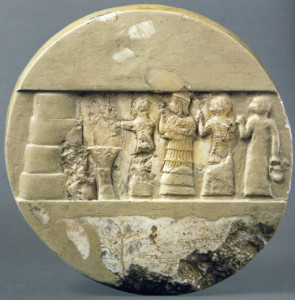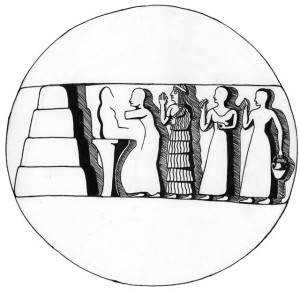Enheduanna
A woman’s name that resounds in the Near East
Enheduanna, the only daughter of five children of Sargon of Akkad, founder of the homonymous dynasty, lived between 2285 and 2250 B.C.
Her name means “High Priestess, ornament of the God, An” (“en” means “high priestess”, “hedu” means “ornament” and “ana” “sky / God An”). Sargon made her the great priestess of the main temple of the moon god Nanna, in the city of Ur. She is definitely one of the most famous women in the ancient history.
One of the tasks of Enheduanna was to administer and control, through his religious authority, the population in the region of Sumer.
Clearly Enheduanna become the symbol of the political synthesis between the Akkadian and the Sumerian world, between the Sumerian and Semitic language and the religious harmony among the goddess Inanna and the goddess Ishtar: the high priestess is presented as the embodiment on earth of the goddess Inanna and her syncretism with the new Akkadian Ishtar.
This great woman continued to carry out her religious policy even after the death of her father Sargon, with the accession to the throne of Rimush, her brother. It seems also she have served Akkad during the reign of Naram-Sin.
At her death, her name have been immortalized: in fact, a semi-divine status was bestowed on her.
Archaeological evidence
The greatest discovery concerning Enheduanna is the disk made of alabaster found by Leonard Woolley during the excavations in 1927 in section C of Giparu, which is the residence of the high priestess of Nanna at Ur. The votive plate shows relief figures: a woman, identified as Enheduanna, offers ritual libations to the goddess Inanna / Ishtar in traditional priestly clothes; She is the highest figure among all.
Behind the high priestess there are two figures, probably male. On the back of the disk there is a fragmentary inscription which recalls the true identity of Enheduanna as the real daughter of Sargon and true servant of Nanna.
They were also found two seals bearing the name Enkheduanna in the Royal Cemetery of Ur: these belonged to her servants and they have been dated to the Sargonic period.
Enheduanna the poetess
Enheduanna wrote a great number of hymns: today we can ascribe to her 42 works, found in all the lands of Sumer and Akkad. Hymns were written in Sumerian language, despite the idiom established by the rise of the Akkadian dynasty was the Semitic.
There are several collections of hymns: “The Sumerian Temple Hymns”, “Inanna and Ebih”, “The Exaltation of Inanna”, “Hymn to Nanna”, “The Lady with a Big Heart”, first and unique in their kind. Within these songs, not only her feelings towards the goddess for which she is endlessly devoted came out, but also her personal attitudes about war, her times, the world in which she lived, her reflections about her frustrations and her hopes. Her manner of writing is very direct.
Enheduanna considered Inanna her personal goddess: this is why the priestess worshiped this deity above all the other gods and addressed personally to Inanna inside her hymns, almost intimately more than ceremonial.
Exaltation of Inanna
NIN-ME-ŠÁR-RA (Queen of all the me)
Queen of all given powers
unveiled clear light
unfailing woman wearing brilliance
cherished in heaven and earth
chosen, sanctified in heaven
You
grand in your adornments
crowned with your beloved goodness
rightfully you are High Priestess
your hands seize the seven fixed powers
my queen of fundamental forces
guardian of essential cosmic sources
you lift up the elements
bind them to your hands
gather in powers
press them to your breast
It seems that the name of Enheduanna can not and should not be limited only to the character of Sargon, her father: this woman has created her own independence, her own personality clearly visible not only in her competence to manage the entire Sumer’s religion, but especially in the ability to demonstrate and to assert her intellectual skills.
Her cleverness to write with passion, inspiration and wisdom, makes her a princess, a priestess, but mostly a poetess, a great spokeswoman of culture in the Ancient Mesopotamia.
°°°°°°°°°°°°°°°°°°°°°°°°°°°°°°°°°°°°°°°°°°°°°°°°°°°°°°°°°°°°°°°°°°°°°°°°°°°°°°°°°°°°°°°°°°°°°°°
Il nome di donna che risuona nel Vicino Oriente
Enheduanna, unica femmina dei cinque figli di Sargon di Akkad, fondatore dell’omonima dinastia, visse tra il 2285 e il 2250 a.C.
Il suo nome vuol dire “Grande Sacerdotessa, Ornamento del Dio An” (“en” significa “grande sacerdotessa”, ”hedu” vuol dire “ ornamento” e “Ana” “del cielo/del dio An”). Sargon la fece diventare sacerdotessa del grande tempio del dio lunare Nanna ad Ur. È sicuramente una delle prime donne nella storia di cui si conosce il nome.
Uno dei compiti di Enheduanna era quello di amministrare e tenere sotto controllo, attraverso la sua autorità religiosa, la popolazione nella regione di Sumer.
In un certo senso Enheduanna diventa il simbolo di quella sintesi politica fra il mondo accadico e quello sumerico, quella linguistica fra il sumerico e il semitico e quella religiosa fra la dea Inanna e la dea Ishtar: la grande sacerdotessa si presenta come la personificazione in terra della dea Inanna e il suo sincretismo con l’Ishtar akkadica.
Questa grande donna continuò a portare avanti la sua politica religiosa anche successivamente alla morte del padre Sargon, con l’ascesa al trono del successore Rimush, suo fratello. Sembra abbia servito Akkad anche durante una parte del regno di Naram-Sin.
Alla sua morte, il suo nome viene reso immortale: le viene conferito, infatti, uno status semi-divino.
Testimonianze archeologiche
La più grande scoperta relativa a Enheduanna è il disco in alabastro rinvenuto da Leonard Woolley nel 1927 durante gli scavi nella sezione C del Giparu, ovvero la residenza della somma sacerdotessa di Nanna a Ur. La piastra votiva rappresenta delle figure in rilievo: una donna, identificata come Enheduanna, offre libagioni rituali alla dea Inanna / Ishtar nelle tradizionali vesti sacerdotali; è la figura più alta di tutte. Dietro la grande sacerdotessa vi sono due figure, probabilmente maschili. Sul retro del disco vi è un’iscrizione frammentaria in cui si ricorda la vera identità di Enheduanna in quanto figlia di Sargon e vera servitrice di Nanna.
Inoltre sono stati rinvenuti due sigilli che riportano il nome di Enheduanna all’interno del Cimitero Reale di Ur: questi appartenevano ai suoi servi e sono stati datati al periodo sargonico.
Enheduanna la donna poeta
Enheduanna scrisse un grande numero di inni: oggi sono attribuibili a lei 42 scritti, rinvenuti in tutto il territorio di Sumer e Akkad. Gli inni, nonostante la lingua affermata dall’ascesa della dinastia accadica fosse ormai quella semitica, vengono scritti in sumerico.
Ci sono diverse collezioni di inni: “Gli Inni Sumeri del Tempio”, “Inanna e Ebih”, “L’esaltazione di Inanna”, “Inno a Nanna”, “La Signora dal Grande Cuore”, primi e unici nella loro tipologia. All’interno di questi inni spiccano non solo i suoi sentimenti nei confronti della divinità alla quale è immensamente devota, ma anche le sue opinioni personali riguardo la guerra, i tempi che intercorrevano, il mondo nel quale viveva, le sue riflessioni riguardo le sue frustrazioni e le sue speranze. Il suo modo di scrivere è molto diretto.
Enheduanna considerava Inanna la sua dea personale: è questo il motivo per cui la sacerdotessa venerava la dea sopra tutte le altre divinità e si rivolgeva personalmente a lei all’interno dei suoi inni, quasi in modo intimo più che cerimoniale.
Esaltazione di Inanna
NIN-ME-ŠÁR-RA (Regina di tutti i me)
Regina di tutti i poteri conferiti
svelata nella chiara luce
donna infallibile che indossa brillantezza
cara in cielo e terra
scelta, santificata nel cielo
Tu
grande nelle tue decorazioni
coronata con la tua amata bontà
giustamente tu sei la Grande Sacerdotessa
le tue mani afferrano i sette poteri fissati
mia regina di forze fondamentali
guardiana di sorgenti cosmiche essenziali
tu alzi gli elementi
legandoli alle tue mani
riunendoli in poteri
premendoli sul tuo seno
Sembra dunque che il nome di Enheduanna non può e non deve essere limitato unicamente alla figura del padre Sargon: questa donna si è creata una propria indipendenza, una propria personalità ben visibile non solo nella sua capacità di amministrare la religione dell’intero Sumer, ma soprattutto nell’abilità di dimostrare e affermare le sue capacità intellettuali.
La sua bravura nello scrivere con passione, ispirazione e saggezza, la rende una principessa, sacerdotessa, ma soprattutto poetessa, una notevole portavoce femminile della cultura dell’Antica Mesopotamia.


